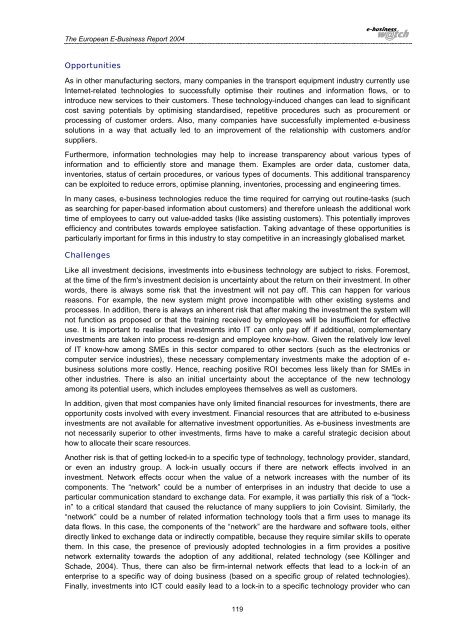The European e-Business Report 2004 - Berlecon Research GmbH
The European e-Business Report 2004 - Berlecon Research GmbH
The European e-Business Report 2004 - Berlecon Research GmbH
Create successful ePaper yourself
Turn your PDF publications into a flip-book with our unique Google optimized e-Paper software.
<strong>The</strong> <strong>European</strong> E-<strong>Business</strong> <strong>Report</strong> <strong>2004</strong>OpportunitiesAs in other manufacturing sectors, many companies in the transport equipment industry currently useInternet-related technologies to successfully optimise their routines and information flows, or tointroduce new services to their customers. <strong>The</strong>se technology-induced changes can lead to significantcost saving potentials by optimising standardised, repetitive procedures such as procurement orprocessing of customer orders. Also, many companies have successfully implemented e-businesssolutions in a way that actually led to an improvement of the relationship with customers and/orsuppliers.Furthermore, information technologies may help to increase transparency about various types ofinformation and to efficiently store and manage them. Examples are order data, customer data,inventories, status of certain procedures, or various types of documents. This additional transparencycan be exploited to reduce errors, optimise planning, inventories, processing and engineering times.In many cases, e-business technologies reduce the time required for carrying out routine-tasks (suchas searching for paper-based information about customers) and therefore unleash the additional worktime of employees to carry out value-added tasks (like assisting customers). This potentially improvesefficiency and contributes towards employee satisfaction. Taking advantage of these opportunities isparticularly important for firms in this industry to stay competitive in an increasingly globalised market.ChallengesLike all investment decisions, investments into e-business technology are subject to risks. Foremost,at the time of the firm's investment decision is uncertainty about the return on their investment. In otherwords, there is always some risk that the investment will not pay off. This can happen for variousreasons. For example, the new system might prove incompatible with other existing systems andprocesses. In addition, there is always an inherent risk that after making the investment the system willnot function as proposed or that the training received by employees will be insufficient for effectiveuse. It is important to realise that investments into IT can only pay off if additional, complementaryinvestments are taken into process re-design and employee know-how. Given the relatively low levelof IT know-how among SMEs in this sector compared to other sectors (such as the electronics orcomputer service industries), these necessary complementary investments make the adoption of e-business solutions more costly. Hence, reaching positive ROI becomes less likely than for SMEs inother industries. <strong>The</strong>re is also an initial uncertainty about the acceptance of the new technologyamong its potential users, which includes employees themselves as well as customers.In addition, given that most companies have only limited financial resources for investments, there areopportunity costs involved with every investment. Financial resources that are attributed to e-businessinvestments are not available for alternative investment opportunities. As e-business investments arenot necessarily superior to other investments, firms have to make a careful strategic decision abouthow to allocate their scare resources.Another risk is that of getting locked-in to a specific type of technology, technology provider, standard,or even an industry group. A lock-in usually occurs if there are network effects involved in aninvestment. Network effects occur when the value of a network increases with the number of itscomponents. <strong>The</strong> “network” could be a number of enterprises in an industry that decide to use aparticular communication standard to exchange data. For example, it was partially this risk of a “lockin”to a critical standard that caused the reluctance of many suppliers to join Covisint. Similarly, the“network” could be a number of related information technology tools that a firm uses to manage itsdata flows. In this case, the components of the “network” are the hardware and software tools, eitherdirectly linked to exchange data or indirectly compatible, because they require similar skills to operatethem. In this case, the presence of previously adopted technologies in a firm provides a positivenetwork externality towards the adoption of any additional, related technology (see Köllinger andSchade, <strong>2004</strong>). Thus, there can also be firm-internal network effects that lead to a lock-in of anenterprise to a specific way of doing business (based on a specific group of related technologies).Finally, investments into ICT could easily lead to a lock-in to a specific technology provider who can119
















